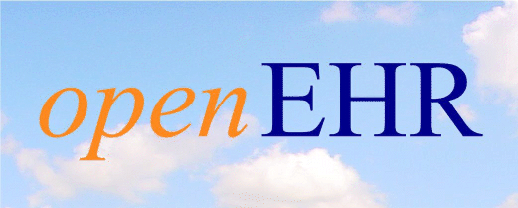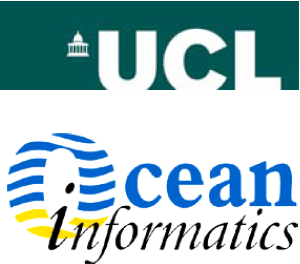Demographic Information Model
| Editors: {T Beale, S Heard}a, {D Kalra, D Lloyd}b | ||
|---|---|---|
| Revision: 2.0.1 | Pages: 25 | Date of issue: 23 Feb 2006 |
- a.
- Ocean Informatics
- b.
- Centre for Health Informatics and Multi-professional Education, University College London
Keywords: EHR, reference model, demographics, openehr
| EHR Extract | ||||||
|---|---|---|---|---|---|---|
| EHR | Demographic | Integration | Template OM | |||
| Composition | openEHR Archetype Profile | |||||
| Security | Common | Archetype OM | ADL | |||
| Data Structures | ||||||
| Data Types | ||||||
| Support | ||||||
© 2003-2007 The openEHR Foundation.
The openEHR Foundation is an independent, non-profit community, facilitating the sharing of health records by consumers and clinicians via open-source, standards-based implementations.
| Founding | David Ingram, Professor of Health Informatics, |
|---|---|
| Chairman | CHIME, University College London |
| Founding | Dr P Schloeffel, Dr S Heard, Dr D Kalra, D Lloyd, T Beale |
| Members | |
| email: info@openEHR.org web: http://www.openEHR.org |
Rev 2.0.1
Copyright Notice
© Copyright openEHR Foundation 2001 - 2007 All Rights Reserved
- This document is protected by copyright and/or database right throughout the world and is owned by the openEHR Foundation.
- You may read and print the document for private, non-commercial use.
- You may use this document (in whole or in part) for the purposes of making presentations and education, so long as such purposes are non-commercial and are designed to comment on, further the goals of, or inform third parties about, openEHR.
- You must not alter, modify, add to or delete anything from the document you use (except as is permitted in paragraphs 2 and 3 above).
- You shall, in any use of this document, include an acknowledgement in the form: "© Copyright openEHR Foundation 2001-2007. All rights reserved. www.openEHR.org"
- This document is being provided as a service to the academic community and on a non-commercial basis. Accordingly, to the fullest extent permitted under applicable law, the openEHR Foundation accepts no liability and offers no warranties in relation to the materials and documentation and their content.
- If you wish to commercialise, license, sell, distribute, use or otherwise copy the materials and documents on this site other than as provided for in paragraphs 1 to 6 above, you must comply with the terms and conditions of the openEHR Free Commercial Use Licence, or enter into a separate written agreement with openEHR Foundation covering such activities. The terms and conditions of the openEHR Free Commercial Use Licence can be found at http://www.openehr.org/free_commercial_use.htm
Date of Issue: 23 Feb 2006 Page 2 of 25 Editors:{T Beale, S Heard}, {D Kalra, D Lloyd}
© 2003-2007 The openEHR Foundation. email: info@openEHR.org web: http://www.openEHR.org
Rev 2.0.1
Amendment Record
| Issue | Details | Raiser | Completed |
|---|---|---|---|
| R E L E A S E 1.0.1 | |||
| 2.0.1 | CR-000200. Correct Release 1.0 typographical errors. | D Lloyd | 23 Feb 2006 |
| R E L E A S E 1.0 | |||
| 2.0 | CR-000189. Add LOCATABLE.parent. New invariant in PARTY. CR-000190. Rename VERSION_REPOSITORY to VERSIONED_OBJECT. CR-000194: Correct anomalies with LOCATABLE.uid CR-000161. Support distributed versioning. | S Heard T Beale H Frankel T Beale T Beale H Frankel | 25 Jan 2006 |
| R E L E A S E 0.96 | |||
| R E L E A S E 0.95 | |||
| 1.4.7 | CR-000133. Remove details /= Void invariant from PARTY | R Chen | 12 Mar 2005 |
| 1.4.6 | CR-000048. Pre-release review of documents. Corrected STRUCTURE to be ITEM_STRUCTURE. Make ACTOR.languages a List not a Set. | D Lloyd | 22 Feb 2005 |
| 1.4.5 | CR-000024. Revert meaning to STRING and rename as archetype_node_id. CR-000118. Make package names lower case. | S Heard, T Beale T Beale | 10 Jan 2005 |
| R E L E A S E 0.9 | |||
| 1.4.4 | CR-000041. Visually differentiate primitive types in openEHR documents. | D Lloyd | 04 Oct 2003 |
| 1.4.3 | CR-000013. Rename key classes, according to CEN ENV 13606. | S Heard, D Kalra, T Beale | 15 Sep 2003 |
| 1.4.2 | CR-000035. Clarify circular relationships between PARTY and PARTY_REL. | Z Tun | 14 Aug 2003 |
| 1.4.1 | CR-000003. Removed ARCHETYPED and VERSIONABLE classes. | T Beale, Z Tun | 18 Mar 2003 |
| 1.4 | Formally validated using ISE Eiffel 5.2. Minor corrections to invariants. | T Beale | 25 Feb 2003 |
| 1.3.1 | Review by H Frankel, MCA. Corrections to diagrams and class texts. Improved PARTY_RELATIONSHIP semantics. Added Patient instance example. Made time_validity attributes optional. | T Beale | 13 Feb 2003 |
| 1.3 | Corrections to diagrams and class texts. Inheritance changed to ARCHETYPED for most key classes. Some instance examples added. | Z Tun, T Beale | 08 Jan 2003 |
| 1.2 | General modifications, addition of CAPABILITY class. | T Beale, D Lloyd | 22 Oct 2002 |
Editors:{T Beale, S Heard}, {D Kalra, D Lloyd} Page 3 of 25 Date of Issue: 23 Feb 2006
Rev 2.0.1
| Issue | Details | Raiser | Completed |
|---|---|---|---|
| 1.1 | Renamed CONTACT_DESCRIPTOR to CONTACT. Removed CON-TACT.role. Renamed PARTY_ROLE to ROLE. Changed CONTACT.address to addresses. Renamed SPATIAL to STRUCTURE. Introduced PARTY and ACTOR classes. | T Beale | 18 Sep 2002 |
| 1.0 | Created from EHR RM. | T Beale | 28 Aug 2002 |
Acknowledgements
The work reported in this paper has been funded in by a number of organisations, including The University College, London; The Cooperative Research Centres Program through the Department of the Prime Minister and Cabinet of the Commonwealth Government of Australia; Ocean Informatics, Australia.
Date of Issue: 23 Feb 2006 Page 4 of 25 Editors:{T Beale, S Heard}, {D Kalra, D Lloyd}
© 2003-2007 The openEHR Foundation. email: info@openEHR.org web: http://www.openEHR.org
Rev 2.0.1
Table of Contents
Copyright Notice .......................................................................................2 Amendment Record ....................................................................................3 Acknowledgements .....................................................................................4 Table of Contents ........................................................................................5
1 Introduction.............................................................................. 7
2 Demographic Package ............................................................. 9
2.1.2 Names and Addresses ....................................................................10
2.1.4 Party Relationships ........................................................................10
2.1.5 Versioning Semantics.....................................................................11
2.2.2 PARTY_IDENTITY Class.............................................................12
2.2.3 CONTACT Class ...........................................................................13
2.2.4 ADDRESS Class............................................................................13
2.2.5 ACTOR Class ................................................................................14
2.2.6 PERSON Class ..............................................................................15
2.2.7 ORGANISATION Class ................................................................15
2.2.8 GROUP Class ................................................................................16
2.2.9 AGENT Class ................................................................................16
2.2.11 CAPABILITY Class ......................................................................17
2.2.12 PARTY_RELATIONSHIP Class ...................................................17
A References ............................................................................... 23
Editors:{T Beale, S Heard}, {D Kalra, D Lloyd} Page 5 of 25 Date of Issue: 23 Feb 2006
© 2003-2007 The openEHR Foundation. email: info@openEHR.org web: http://www.openEHR.org
Rev 2.0.1
Date of Issue: 23 Feb 2006 Page 6 of 25 Editors:{T Beale, S Heard}, {D Kalra, D Lloyd}
© 2003-2007 The openEHR Foundation. email: info@openEHR.org web: http://www.openEHR.org
Demographic Information Model Introduction Rev 2.0.1
Introduction
1.1 Purpose
This document describes the architecture of the openEHR Demographic Information Model. The semantics are drawn from previous work in GEHR, existing models in CEN 13606 and the HL7v3 RIM, and other work done in Australia.
The intended audience includes:
- Standards bodies producing health informatics standards;
- Software development groups using openEHR;
- Academic groups using openEHR;
- The open source healthcare community;
- Medical informaticians and clinicians intersted in health information;
- Health data managers.
1.2 Related Documents
Prerequisite documents for reading this document include:
- The openEHR Architecture Overview
- The openEHR Modelling Guide
- The openEHR Support Information Model
- The openEHR Data Types Information Model
• The openEHR Common Information Model Other documents describing related models, include:
- The openEHR EHR Information Model
- The openEHR Demographic Model
1.3 Status
This document is under development, and is published as a proposal for input to standards processes and implementation works.
This document is available at http://svn.openehr.org/specification/TAGS/Release 1.0.1/publishing/architecture/rm/demographic_im.pdf .
The latest version of this document can be found at http://svn.openehr.org/specifica tion/TRUNK/publishing/architecture/rm/demographic_im.pdf .
1.4 Peer review
Areas where more analysis or explanation is required are indicated with “to be continued” paragraphs like the following:
To Be Continued: more work required
Editors:{T Beale, S Heard}, {D Kalra, D Lloyd} Page 7 of 25 Date of Issue: 23 Feb 2006
© 2003-2007 The openEHR Foundation. email: info@openEHR.org web: http://www.openEHR.org
Introduction Demographic Information Model Rev 2.0.1
Reviewers are encouraged to comment on and/or advise on these paragraphs as well as the main content. Please send requests for information to info@openEHR.org. Feedback should preferably be provided on the mailing list openehr-technical@openehr.org, or by private email.
1.5 Conformance
Conformance of a data or software artifact to an openEHR Reference Model specification is determined by a formal test of that artifact against the relevant openEHR Implementation Technology Specification(s) (ITSs), such as an IDL interface or an XML-schema. Since ITSs are formal, automated derivations from the Reference Model, ITS conformance indicates RM conformance.
Date of Issue: 23 Feb 2006 Page 8 of 25 Editors:{T Beale, S Heard}, {D Kalra, D Lloyd}
© 2003-2007 The openEHR Foundation. email: info@openEHR.org web: http://www.openEHR.org
Demographic Information Model Demographic Package Rev 2.0.1
Demographic Package
2.1 Overview
The demographic model illustrated in FIGURE 1 is a generalised model of the facts one might expect to see in a demographic server. The purpose of the model is as a specification of a demographic service, either standalone, or a “wrapper” service for an existing system such as a patient master index (PMI). In the latter situation, it is used to add the required openEHR semantics, particularly versioning, to an existing service.
LOCATABLE
(rm.common.archetyped)
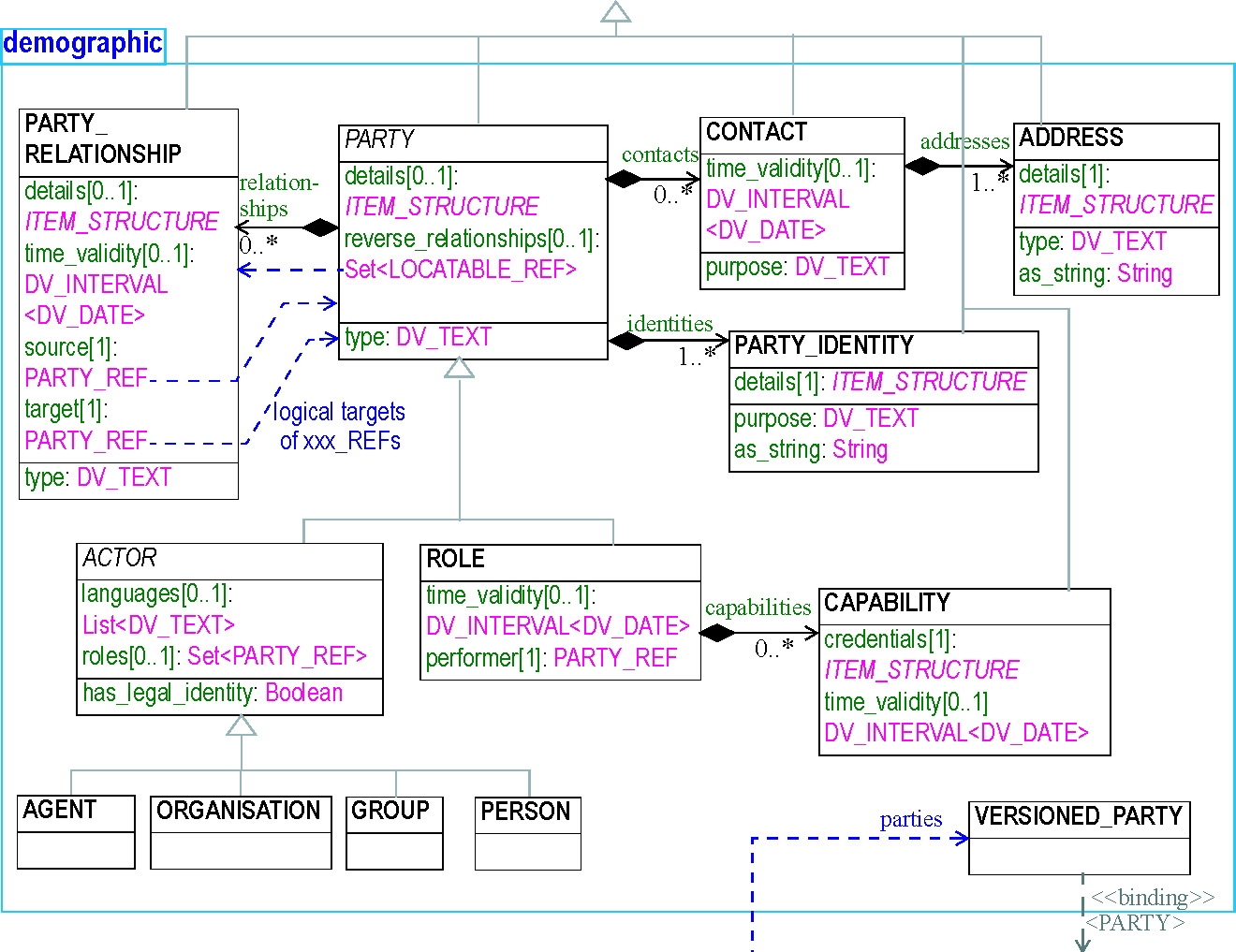
repository
VERSIONED_OBJECT<T>
(“demographics”)
(rm.common.change_control)
FIGURE 1 rm.demographic Package
The general design is based on the scheme of party and accountability described by Fowler [19] , and is influenced by clinical adaptations including work done in Australia [11] and the HL7v3 RIM [15] (itself influenced by the Fowler models).
One of the main design criteria of the model is that it expresses attributes and relationships of demographic entities which exist regardless of particular clinical involvements or participations in particu
Editors:{T Beale, S Heard}, {D Kalra, D Lloyd} Page 9 of 25 Date of Issue: 23 Feb 2006
© 2003-2007 The openEHR Foundation. email: info@openEHR.org web: http://www.openEHR.org
Demographic Package Demographic Information Model Rev 2.0.1
lar events. Participations are meaningful only within the context of the health record or other relevant model where they record context-specific relationships between demographic entities and events in the real world.
Another criterion is that instances of the classes in the model must be serialisable into an EHR Extract in an unambgiuous way. This requires that each PARTY be a self-contained hierarchy of data, in the same way as distinct COMPOSITIONs in the EHR model are distinct hierarchies in an Extract. In order to ensure this condition, PARTY_RELATIONSHIPs must be implemented correctly, so as to prevent endless traversal of all PARTY objects through their relationships, when serialising. See Party Relationships below for details.
2.1.1 Archetyping
The model is designed to be used with archetypes, hence the generic nature of all entities. Every class containing an attribute of the form details:STRUCTURE is a completely archetypable structure. As a result, archetypes can be defined for concepts such as particular kinds of PERSON, ORGANISATION; for actual ROLEs such as “health care practitioner”, and for party identities and addresses.
2.1.2 Names and Addresses
Classes have been included for PARTY_IDENTITY and ADDRESS, even though they contain only a link to details, in the form of the generic STRUCTURE class. This is not strictly necessary - it could have been done simply using appropriately named attributes in the classes PARTY and CONTACT - but is done to provide a place to add specific semantics in future releases of the model. It is also expected to make software development easier, since it provides explicit classes to which behaviour and other implementation attributes can be added. Lastly, it allows the notions of PARTY_IDENTITY and ADDRESS to be explicitly used in archetype-authoring tools.
Instances of PARTY_IDENTITY, linked to PARTY by the attribute identities are intended to express the names of people, organisations, and other actors - that is names which are “owned” by the party, e.g. self-declared (in the case of institutions and companies) or by virtue of social relations (names given by parents, tribes etc). Identifiers of Parties given by other organisations, or the state are not represented in this way, and should be recorded in the PARTY.details structure instead (see below).
2.1.3 Party Identification
Identifiers of Parties given by organisations or the state are treated as any other attribute of a Party,
i.e. recorded as part of the data in the PARTY.details structure. Identifiers of Party instances in the system are provided in the same way as identifiers of Compositions in the EHR: via the uid attribute (type OBJECT_VERSION_ID) of the containing VERSION. These identifiers are used in all cross-references between Parties, and between Parties and Perty_relationships.
2.1.4 Party Relationships
Relationships between parties in the real world may be expressed using PARTY_RELATIONSHIP objects, as illustrated in FIGURE 2.
![]() reverse_relationships
reverse_relationships
relationships
FIGURE 2 General Relationship Model
Date of Issue: 23 Feb 2006 Page 10 of 25 Editors:{T Beale, S Heard}, {D Kalra, D Lloyd}
© 2003-2007 The openEHR Foundation. email: info@openEHR.org web: http://www.openEHR.org
Demographic Information Model Demographic Package Rev 2.0.1
Relationships are considered directional, hence the use of the attribute names source and target, however, these names are otherwise neutral, and give no indication as to the meaning of the relationships, such as which party is responsible and which accountable (for comparison, see the demographic models of Fowler [19] ). Accordingly, each Party involved in a relationship includes it in its relationships list, if it is at the source end, or in the reverse_relationships list, if at the target end.
The usual way to determine the directionality of a relationship between two Parties is usually by which Party’s actions caused the relationship to come into being. For example, a relationship representing the concept “patient”, between a health consumer and a health care organisation would have the consumer as source and the organisation as target.
PARTY_RELATIONSHIPs are stored as part of the data of the PARTY designated as the source. This means that the relationships attribute is by value, while reverse_relationships is by references, as are PARTY_RELATIONSHIP.source and target. The actual kind of reference is via the use of OBJECT_REFscontaining HIER_OBJECT_IDs to denote the Version container of a Party, rather than OBJECT_VERSION_IDs, which would denote particular versions. Logically this implements the semantic that such relationships in the real world are between continuants, i.e. the real Parties, not just one of their version instances in a demographic system.
2.1.5 Versioning Semantics
The class PARTY and its descendants ACTOR and ROLE are all potentially versioned in a demographic system. A Version of a PARTY includes all the compositional parts, such as identities, contacts, Party relatoinships of which it is the source. Every Party is stored in its own Version container.
2.2 Class Definitions
2.2.1 PARTY Class
| CLASS | PARTY (abstract) | |
|---|---|---|
| Purpose | Ancestor of all party types, including real world entities and their roles. A party is any entity which can participate in an activity. The name attribute inherited from LOCATABLE is used to indicate the actual type of party (note that the actual names, i.e. identities of parties are indicated in the identities attribute, not the name attribute). | |
| CEN | healthcare agent | |
| HL7 | Entity | |
| Inherit | LOCATABLE | |
| Attributes | Signature | Meaning |
| 1..1 (redefined) | uid: HIER_OBJECT_ID | Identifier of this Party. |
| 1..1 | identities: Set<PARTY_IDENTITY> | Identities used by the party to identify itself, such as legal name, stage names, aliases, nicknames and so on. |
Editors:{T Beale, S Heard}, {D Kalra, D Lloyd} Page 11 of 25 Date of Issue: 23 Feb 2006
Demographic Package Demographic Information Model Rev 2.0.1
| CLASS | PARTY (abstract) | |
|---|---|---|
| 0..1 | contacts: Set<CONTACT> | Contacts for this party. |
| 0..1 | relationships: Set<PARTY_RELATIONSHIP> | Relationships in which this role takes part as source. |
| 0..1 | reverse_relationships: Set<LOCATABLE_REF> | Relationships in which this role takes part as target. |
| 0..1 | details: ITEM_STRUCTURE | All other details for this party. |
| Functions | Signature | Meaning |
| type: DV_TEXT | Type of party, such as “PERSON”, “ORGANISATION”, etc. Role name, e.g. “general practitioner”, “nurse”, “private citizen”. Taken from inherited name attribute. | |
| Invariants | Uid_valid: uid /= Void Type_valid: type = name Identities_valid: identities /= Void and then not identities.is_empty Contacts_valid: contacts /= Void implies not contacts.is_empty Relationships_validity: relationships /= Void implies (not relation-ships.is_empty and then relationships.for_all(source = Current) Reverse_relationships_validity: reverse_relationships /= Void implies (not reverse_relationships.empty and then reverse_relationships.for_all(item | repository(“demographics”).all_party_relationships.has_object(item) and then repository(“demographics”).all_party_relationships.object(item).target = Current)) Is_archetype_root: is_archetype_root No_parent: parent = Void | |
2.2.2 PARTY_IDENTITY Class
| CLASS | PARTY_IDENTITY | |
|---|---|---|
| Purpose | An identity “owned” by a PARTY, such as a person name or company name, and which is used by the party to identify itself. Actual structure is archetyped. | |
| CEN | Person Name (data type). | |
| HL7 | Person Name (PN) (data type). | |
| Inherit | LOCATABLE | |
| Attributes | Signature | Meaning |
| 0..1 | details: ITEM_STRUCTURE | The value of the indentity. This will often taken the form of a parsable string or a small structure of strings. |
Date of Issue: 23 Feb 2006 Page 12 of 25 Editors:{T Beale, S Heard}, {D Kalra, D Lloyd}
© 2003-2007 The openEHR Foundation. email: info@openEHR.org web: http://www.openEHR.org
Demographic Information Model Demographic Package Rev 2.0.1
| CLASS | PARTY_IDENTITY | |
|---|---|---|
| Functions | Signature | Meaning |
| 1..1 | purpose: DV_TEXT | Purpose of identity, e.g. “legal”, “stagename”, “nickname”, “tribal name”, “trading name”. Taken from value of inherited name attribute. |
| as_string: String | Identity in the form of a single string. | |
| Invariants | Purpose_valid: purpose = name Details_exists: details /= Void | |
2.2.3 CONTACT Class
| CLASS | CONTACT | |
|---|---|---|
| Purpose | Description of a means of contact of a party. Actual structure is archetyped. | |
| Inherit | LOCATABLE | |
| Attributes | Signature | Meaning |
| 0..1 | time_validity: DV_INTERVAL <DV_DATE> | Valid time interval for this contact descriptor. |
| 1..1 | addresses: List<ADDRESS> | A set of address alternatives for this purpose and time validity. |
| Functions | Signature | Meaning |
| 1..1 | purpose: DV_TEXT | Purpose for which this contact is used, e.g. “mail”, “daytime phone”, etc. Taken from value of inherited name attribute. |
| Invariants | Purpose_valid: purpose = name Addresses_exists: addresses /= Void and then not addresses.empty | |
2.2.4 ADDRESS Class
| CLASS | ADDRESS |
|---|---|
| Purpose | Address of contact, which may be electronic or geographic. |
| CEN | Address (data type) |
| HL7 | Address (AD) (data type) |
| Inherit | LOCATABLE |
Editors:{T Beale, S Heard}, {D Kalra, D Lloyd} Page 13 of 25 Date of Issue: 23 Feb 2006
© 2003-2007 The openEHR Foundation. email: info@openEHR.org web: http://www.openEHR.org
Demographic Package Demographic Information Model Rev 2.0.1
| CLASS | ADDRESS | ||
|---|---|---|---|
| Attributes | Signature | Meaning | |
| 0..1 | details: ITEM_STRUCTURE | The details of the address, in the form of a ITEM_STRUCTURE. This may take the form of a ITEM_SINGLE, whose data item is a parsable string or a list or tree of many parts. | |
| Functions | Signature | Meaning | |
| 1..1 | type: DV_TEXT | Type of address, e.g. “electronic”, “locality”. Taken from value of inherited name attribute. | |
| as_string: String | Address in the form of a single string. | ||
| Invariants | Type_valid: type = name Details_exists: details /= Void | ||
2.2.5 ACTOR Class
| CLASS | ACTOR (abstract) | |
|---|---|---|
| Purpose | Ancestor of all real-world types, including people and organisations. An actor is any real-world entity capable of taking on a role. | |
| CEN | healthcare party | |
| HL7 | Entity | |
| Inherit | PARTY | |
| Attributes | Signature | Meaning |
| 0..1 | roles: Set<PARTY_REF> | Identifiers of the Version container for each Role played by this party. |
| 0..1 | languages: List<DV_TEXT> | Languages which can be used to communicate with this actor, in preferred order of use (if known, else order irrelevant). |
| Functions | Signature | Meaning |
| 1..1 | has_legal_identity: Boolean | True if one there is an identity with purpose “legal identity” |
| Invariants | Roles_valid: roles /= Void implies not roles.is_empty Languages_valid: languages /= Void implies not languages.is_empty Legal_identity_exists: has_legal_identity | |
Date of Issue: 23 Feb 2006 Page 14 of 25 Editors:{T Beale, S Heard}, {D Kalra, D Lloyd}
© 2003-2007 The openEHR Foundation. email: info@openEHR.org web: http://www.openEHR.org
Demographic Information Model Demographic Package Rev 2.0.1
2.2.6 PERSON Class
| CLASS | PERSON | |
|---|---|---|
| Purpose | Generic description of persons. Provides a dedicated type to which Person archetypes can be targeted. | |
| CEN | healthcare person | |
| GEHR | G1_PERSON | |
| HL7 | Person | |
| Inherit | ACTOR | |
| Attributes | Signature | Meaning |
| Invariants | ||
2.2.7 ORGANISATION Class
| CLASS | ORGANISATION | |
|---|---|---|
| Purpose | Generic description of organisations. An organisation is a legally constituted body whose existence (in general) outlives the existence of parties considered to be part of it. | |
| CEN | healthcare organisation | |
| GEHR | G1_HCF | |
| HL7 | ORGANIZATION | |
| Inherit | ACTOR | |
| Attributes | Signature | Meaning |
| Invariants | ||
Editors:{T Beale, S Heard}, {D Kalra, D Lloyd} Page 15 of 25 Date of Issue: 23 Feb 2006
© 2003-2007 The openEHR Foundation. email: info@openEHR.org web: http://www.openEHR.org
Demographic Package Demographic Information Model Rev 2.0.1
2.2.8 GROUP Class
| CLASS | GROUP | |
|---|---|---|
| Purpose | A group is a real world group of parties which is created by another party, usually an organisation, for some specific purpose. A typical clinical example is that of the specialist care team, e.g. “cardiology team”. The members of the group usually work together. | |
| Inherit | ACTOR | |
| Attributes | Signature | Meaning |
| Invariants | ||
2.2.9 AGENT Class
| CLASS | AGENT | |
|---|---|---|
| Purpose | Generic concept of any kind of agent, including devices, software systems, but not humans or organisations. | |
| CEN | healthcare software, healthcare device | |
| HL7 | DEVICE | |
| Inherit | ACTOR | |
| Attributes | Signature | Meaning |
| Invariants | ||
2.2.10 ROLE Class
| CLASS | ROLE |
| Purpose | Generic description of a role performed by an actor. The role corresponds to a competency of the party. Roles are used to define the responsibilities undertaken by a party for a purpose. Roles should have credentials qualifying the performer to perform the role. |
| Use | Roles correspond to concepts like “general practitioner”, “nurse” and so on. |
| CEN | healthcare agent in context |
Date of Issue: 23 Feb 2006 Page 16 of 25 Editors:{T Beale, S Heard}, {D Kalra, D Lloyd}
© 2003-2007 The openEHR Foundation. email: info@openEHR.org web: http://www.openEHR.org
Demographic Information Model Demographic Package Rev 2.0.1
| CLASS | ROLE | |
|---|---|---|
| HL7 | ROLE | |
| Inherit | PARTY | |
| Attributes | Signature | Meaning |
| 0..1 | capabilities: List <CAPABILITY> | The capabilities of this role. |
| 0..1 | time_validity: DV_INTERVAL <DV_DATE> | Valid time interval for this role. |
| 1..1 | performer: PARTY_REF | Reference to Version container of Actor playing the role. |
| Invariants | Capabilities_valid: capabilities /= Void implies not capabilities.empty Performer_exists: performer /= Void | |
2.2.11 CAPABILITY Class
| CLASS | CAPABILITY | |
|---|---|---|
| Purpose | Capability of a role, such as “ehr modifier”, “health care provider”. Capability should be backed up by credentials. | |
| Use | ||
| Inherit | LOCATABLE | |
| Attributes | Signature | Meaning |
| 1..1 | credentials: ITEM_STRUCTURE | The qualifications of the performer of the role for this capability. This might include professional qualifications and official identifications such as provider numbers etc. |
| 0..1 | time_validity: DV_INTERVAL <DV_DATE> | Valid time interval for the credentials of this capability. |
| Invariants | Credentials_exists: credentials /= Void | |
2.2.12 PARTY_RELATIONSHIP Class
| CLASS | PARTY_RELATIONSHIP |
|---|---|
| Purpose | Generic description of a relationship between parties. |
| HL7 | RELATIONSHIP_LINK |
Editors:{T Beale, S Heard}, {D Kalra, D Lloyd} Page 17 of 25 Date of Issue: 23 Feb 2006
© 2003-2007 The openEHR Foundation. email: info@openEHR.org web: http://www.openEHR.org
Demographic Package Demographic Information Model Rev 2.0.1
| CLASS | PARTY_RELATIONSHIP | |
|---|---|---|
| Inherit | LOCATABLE | |
| Attributes | Signature | Meaning |
| 1..1 (redefined) | uid: HIER_OBJECT_ID | Identifier of this Party. |
| 0..1 | details: ITEM_STRUCTURE | The detailed description of the relationship |
| 0..1 | time_validity: DV_INTERVAL <DV_DATE> | Valid time interval for this relationship. |
| 1..1 | source: PARTY_REF | Source of relationship. |
| 1..1 | target: PARTY_REF | Target of relationship. |
| Functions | Signature | Meaning |
| 1..1 | type: DV_TEXT | Type of relationship, such as “employment”, “authority”, “health provision” |
| Invariants | Uid_valid: uid /= Void Type_validity: type = name Source_valid: source /= Void and then source.relationships.has(Current) Target_valid: target /= Void and then not target.reverse_relationships.has(Current) | |
2.3 Instance Examples
In the following instance examples, the values of the attributes uid, source, target, and reverse_relationships are not meant to be taken as literally valid OBJECT_IDs - for the purposes of clarity, simple integers have been used.
2.3.1 Parties
2.3.1.1 Person
FIGURE 3 illustrates a possible set of instances for a PERSON, with home and work contact information. There are separate archetypes for the PERSON, each ADDRESS, and each PARTY_IDENTITY. In
Date of Issue: 23 Feb 2006 Page 18 of 25 Editors:{T Beale, S Heard}, {D Kalra, D Lloyd}
© 2003-2007 The openEHR Foundation. email: info@openEHR.org web: http://www.openEHR.org
Demographic Information Model Demographic Package Rev 2.0.1
the following figure, “meaning” is the meaning from the value of the archetype_node_id attribute, functionally derived from the archetype local ontology.
PARTY_IDENTITY
meaning = “person name” name = “legal name”
CONTACT
name = “home” time_validity =
12/jan/1998 -
 ELEMENT
ELEMENT
items
name = “first names” value = “Robert James”
LIST_S
meaning = “items” name = “items”
ELEMENT
name = “titles” value = “Dr (med)”

addresses
LIST_S ADDRESS
![]() meaning = com address”
meaning = com address”
meaning = “tele
“items” name = “phone”
name = “phone”
items![]() ELEMENT
ELEMENT
name = “area code” value = “08”
ADDRESS
![]() meaning = “apartment address” name = “home address”
meaning = “apartment address” name = “home address”
CONTACT
name = “work” time_validity =
12/jan/1998 -
ELEMENT
name = “number” value = “1234 4321”
items
LIST_S
meaning = “items” name = “address”
ELEMENT
name = “number” value = “5a”
ELEMENT
name = “street nr” value = “38”
ELEMENT
name = “street name” value = “elm”
FIGURE 3 Person Demographic Information
2.3.1.2 Clinician Credentials
2.3.1.3 Health Care Facility
2.3.1.4 Group
FIGURE 4 illustrates the demographic information for a cadiac surgery team in a hospital. The group includes a head surgeon, anaesthetist, assistant surgeon, and presumably others (not shown). Each of
Editors:{T Beale, S Heard}, {D Kalra, D Lloyd} Page 19 of 25 Date of Issue: 23 Feb 2006
© 2003-2007 The openEHR Foundation. email: info@openEHR.org web: http://www.openEHR.org
Demographic Package Demographic Information Model Rev 2.0.1
these members of the team have an employment relationship with the hospital (shown only for one surgeon, in the interests of clarity).
PARTY_REL’SHIP
ROLE
identies
roles
uid = 90
uid = 11
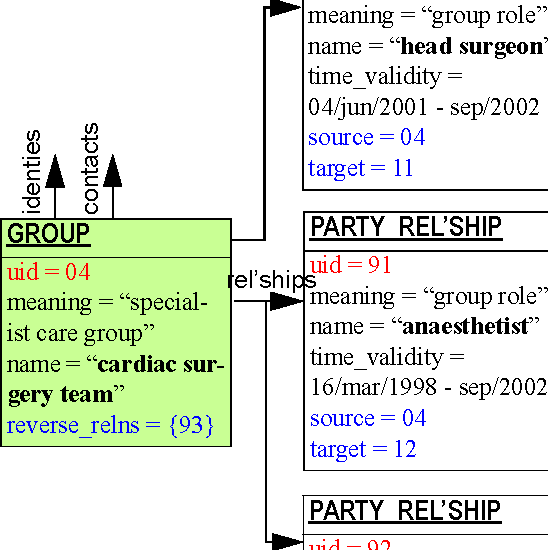
ROLE PARTY_REL’SHIP
roles
uid = 13
uid = 92 meaning = “group role” name = “head surgeon” time_validity = 04/jun/2001 - sep/2002
source = 04 target = 11 meaning = “specialist” name = “cardiac surgeon” time_validity = 27/may/2001 - dec/2005
reverse_relns = {90, 94}
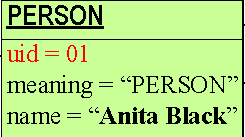
contacts
PARTY_REL’SHIP
ROLE
identies
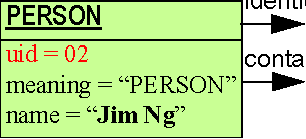
roles
uid = 12
contacts
meaning = “specialist”
name = “anaesthetist” time_validity = 16/mar/1998 - sep/2002
source = 04 target = 12 name = “anaesthetist” time_validity = 16/mar/1998 - dec/2005
reverse_relns = {91, 95}
identies
meaning = “group role” name = “asst. surgeon” time_validity = 5/dec/1999 - sep/2002
source = 04 target = 13 meaning = “specialist” name = “cardiac surgeon” time_validity = 27/may/2001 - dec/2005
reverse_relns = {92, 96}
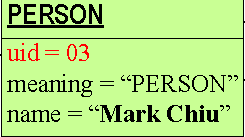
contacts
PARTY_REL’SHIP
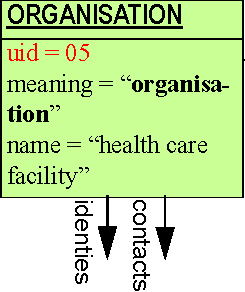
PARTY_REL’SHIP
rel’ships
rel’ships
uid = 94
uid = 93
meaning = “employment”
name = “cardiologist”
time_validity = 27/may/2001 -
dec/2005
target = 11
source = 05 meaning = “cardiology team”
name = “cardiac team #1”
time_validity = 1/jan/1992
sep/2002
source = 05
target = 04
PARTY_REL’SHIP
uid = 95
meaning = “employment” name = “senior anaesthetist” time_validity = 15/feb/2003 - dec/2005
target = 12 source = 05
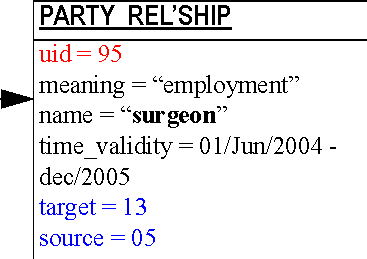
FIGURE 4 Group Demographics
Date of Issue: 23 Feb 2006 Page 20 of 25 Editors:{T Beale, S Heard}, {D Kalra, D Lloyd}
© 2003-2007 The openEHR Foundation. email: info@openEHR.org web: http://www.openEHR.org
Demographic Information Model Demographic Package Rev 2.0.1
2.3.2 Relationships
2.3.2.1 Familial Relationship
2.3.2.2 Employment Relationship
2.3.2.3 Patient
FIGURE 5 shows a simple way of representing the patient relationship between a person and a health care organisation.
![]() identies
identies
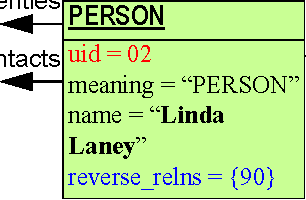 PARTY_REL’SHIP
PARTY_REL’SHIP
identies rel’ns
uid = 90
rel’ns
![]() contacts contacts
contacts contacts
meaning = “patient” name = “patient” time_validity = 1/jan/1992 - 20/jan/1992
source = 01 target = 02
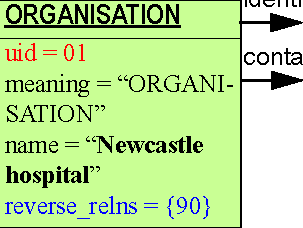
FIGURE 5 Simple Patient Relationship
FIGURE 6 shows the same logical relationship, but with both Parties acting through Roles, representing their status as healthcare consumer and healthcare provider respectively. Each of these Roles has associated credentials which document its official nature within the healthcare system.
CAPABILITY
credentials = medicare nr: 999 time_validity = 16/mar/1998 -
identities contacts
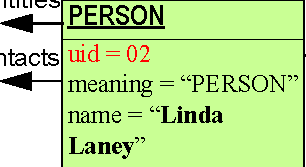
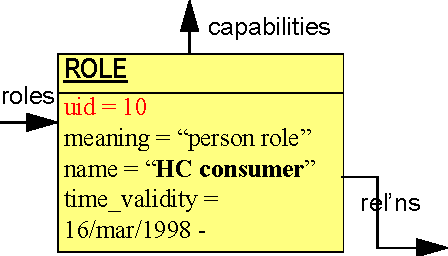
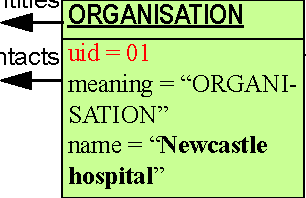 rel’ns roles contacts
rel’ns roles contacts
identities
capabilities
CAPABILITY
credentials = provider nr: 111 time_validity = 1/jan/1980 -
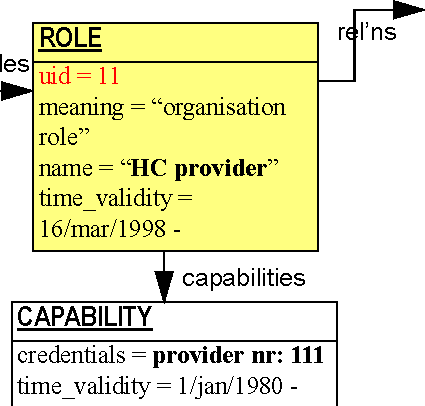
PARTY_REL’SHIP
uid = 90
meaning = “patient” name = “patient” time_validity = 1/jan/1992 - 20/jan/1992
source = 01 target = 02
FIGURE 6 Patient Relationship with Roles and Credentials
Editors:{T Beale, S Heard}, {D Kalra, D Lloyd} Page 21 of 25 Date of Issue: 23 Feb 2006
© 2003-2007 The openEHR Foundation. email: info@openEHR.org web: http://www.openEHR.org
Demographic Package Demographic Information Model Rev 2.0.1
Date of Issue: 23 Feb 2006 Page 22 of 25 Editors:{T Beale, S Heard}, {D Kalra, D Lloyd}
© 2003-2007 The openEHR Foundation. email: info@openEHR.org web: http://www.openEHR.org
Demographic Information Model References Rev 2.0.1
A References
A.1 General
1 Beale T. Archetypes: Constraint-based Domain Models for Future-proof Information Systems. See http://www.deepthought.com.au/it/archetypes.html .
2 Beale T et al. Design Principles for the EHR. See http://www.deepthought.com.au/openEHR .
3 Gray J, Reuter A. Transaction Processing Concepts and Techniques. Morgan Kaufmann 1993.
4 Sowa J F. Knowledge Representation: Logical, philosophical and Computational Foundations. 2000, Brooks/Cole, California.
5 Schloeffel P. (Editor). Requirements for an Electronic Health Record Reference Architecture. International Standards Organisation, Australia; Feb 2002; ISO TC 215/SC N; ISO/WD 18308.
6 Sottile P.A., Ferrara F.M., Grimson W., Kalra D., and Scherrer J.R. The holistic healthcare information system. Toward an Electronic Health Record Europe 1999. Nov 1999; 259-266.
A.2 CEN
7 ENV 13606-1 - Electronic healthcare record communication - Part 1: Extended architecture. CEN/ TC 251 Health Informatics Technical Committee.
8 ENV 13606-2 - Electronic healthcare record communication - Part 2: Domain term list. CEN/ TC 251 Health Informatics Technical Committee.
9 ENV 13606-3 - Electronic healthcare record communication - Part 3: Distribution rules. CEN/ TC 251 Health Informatics Technical Committee.
10 ENV 13606-4 -Electronic Healthcare Record Communication standard Part 4: Messages for the exchange of information. CEN/ TC 251 Health Informatics Technical Committee.
A.3 GEHR Australia
11 Beale T. Northern Territory Health Demographic Model.
12 Heard S. GEHR Project Australia, GPCG Trial. Available at http://www.ge hr.org/gpcg/ehra.htm .
13 Beale T, Heard S. GEHR Technical Requirements. See http://www.gehr.org/technical/require ments/gehr_requirements.html .
A.4 OMG
14 CORBAmed document: Person Identification Service. (March 1999). (Authors?)
Editors:{T Beale, S Heard}, {D Kalra, D Lloyd} Page 23 of 25 Date of Issue: 23 Feb 2006
© 2003-2007 The openEHR Foundation. email: info@openEHR.org web: http://www.openEHR.org
References Demographic Information Model Rev 2.0.1
A.5 HL7
15 HL7 version 3 2nd Ballot specification. Available at http://www.hl7.org .
A.6 Software Engineering
16 Meyer B. Object-oriented Software Construction, 2nd Ed. Prentice Hall 1997 17 Walden K, Nerson J. Seamless Object-oriented Software Architecture. Prentice Hall 1994
18 Gamma E, Helm R, Johnson R, Vlissides J. Design patterns of Reusable Object-oriented Software
Addison-Wesley 1995
19 Fowler M. Analysis Patterns: Reusable Object Models Addison Wesley 1997 20 Fowler M, Scott K. UML Distilled (2nd Ed.) Addison Wesley Longman 2000 21 Booch G, Rumbaugh J, Jacobsen I. The Unified Modelling Language User Guide. Addison es-ley 1999.
A.7 Resources
22 Arden Syntax. http://www.cpmc.columbia.edu/arden/
23 Asbru / The Asgaard Project. http://smi-web.stanford.edu/projects/asgaard/ 24 Digital Imaging ad Communications in Medicine (DICOM). http://medical.nema.org/di
com.html . 25 EON ref required 26 GLIF (Guideline Interchange Format). http://www.glif.org/ .
27 IANA - http://www.iana.org/ . 28 ProForma language for decision support. http://www.acl.icnet.uk/lab/proforma.html . 29 SynEx project, UCL. http://www.chime.ucl.ac.uk/HealthI/SynEx/ .
Date of Issue: 23 Feb 2006 Page 24 of 25 Editors:{T Beale, S Heard}, {D Kalra, D Lloyd}
© 2003-2007 The openEHR Foundation. email: info@openEHR.org web: http://www.openEHR.org
Rev 2.0.1
END OF DOCUMENT
Editors:{T Beale, S Heard}, {D Kalra, D Lloyd} Page 25 of 25 Date of Issue: 23 Feb 2006
© 2003-2007 The openEHR Foundation. email: info@openEHR.org web: http://www.openEHR.org
